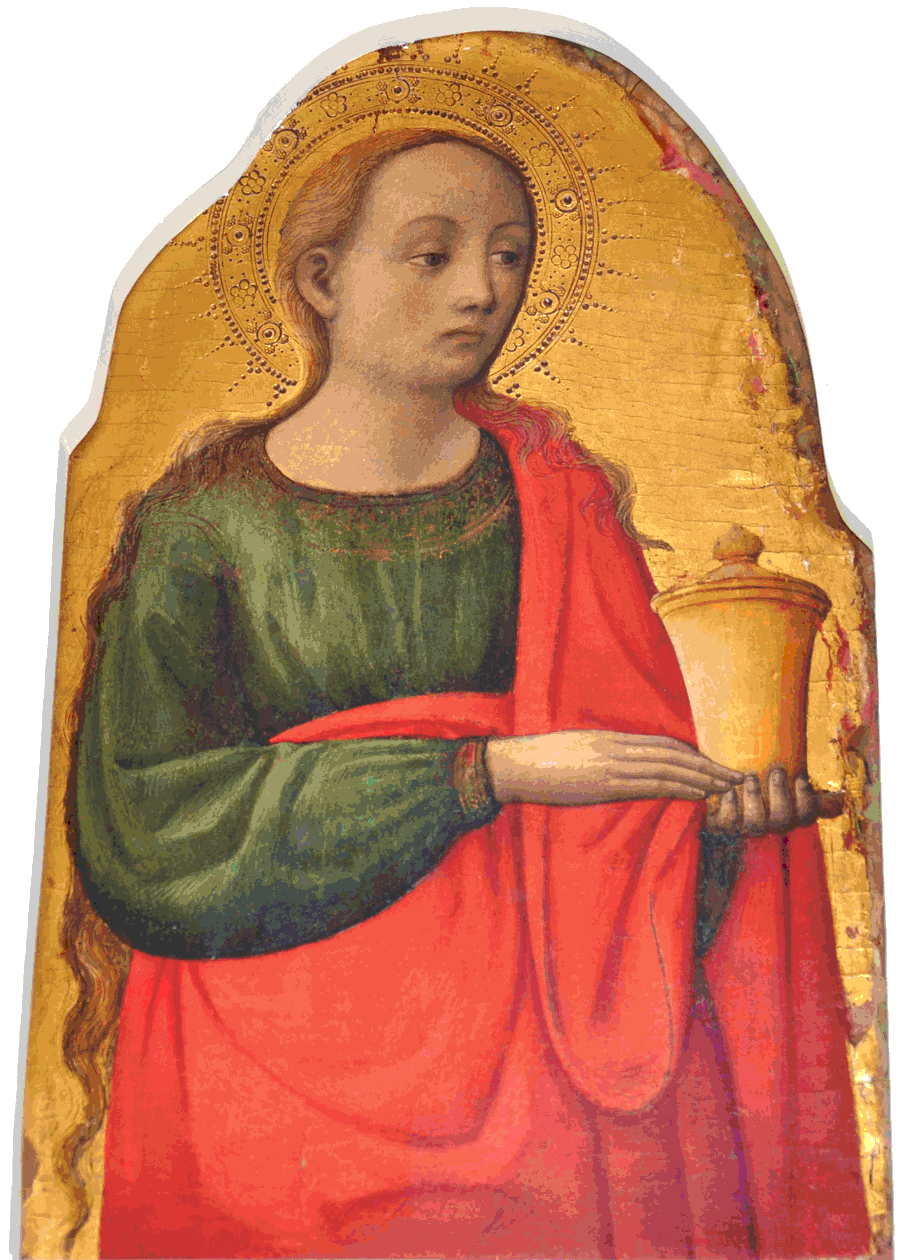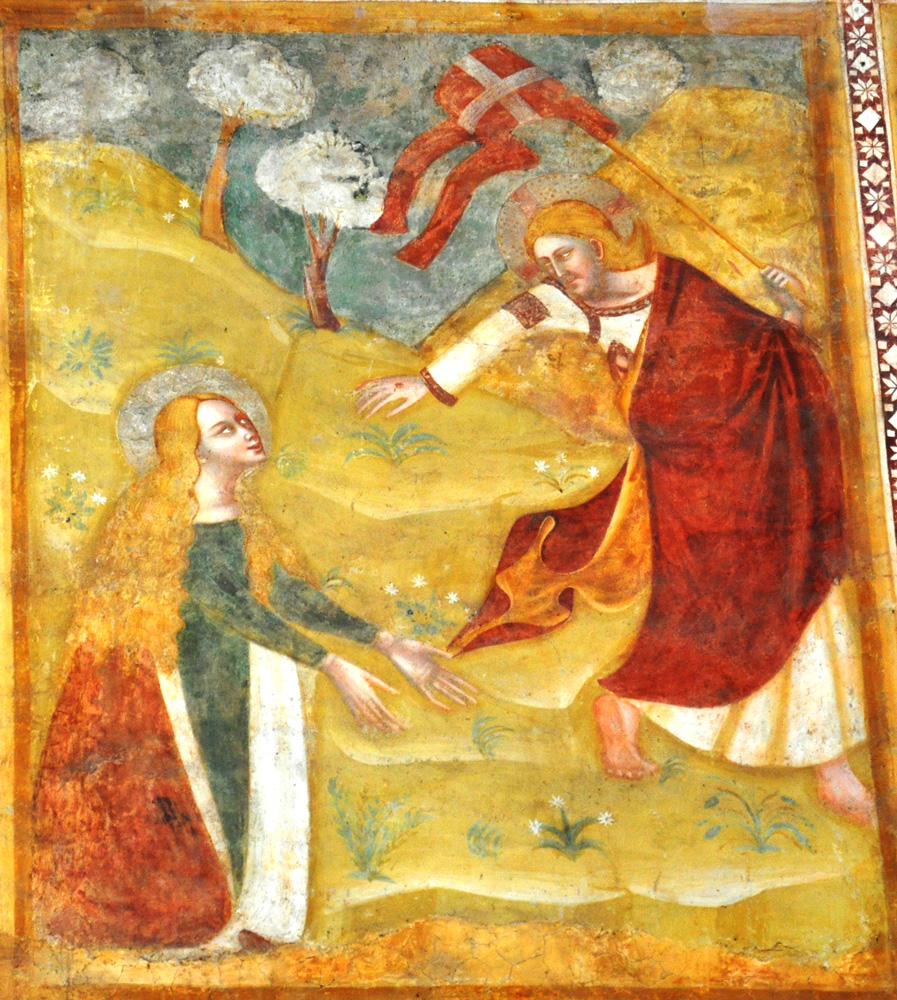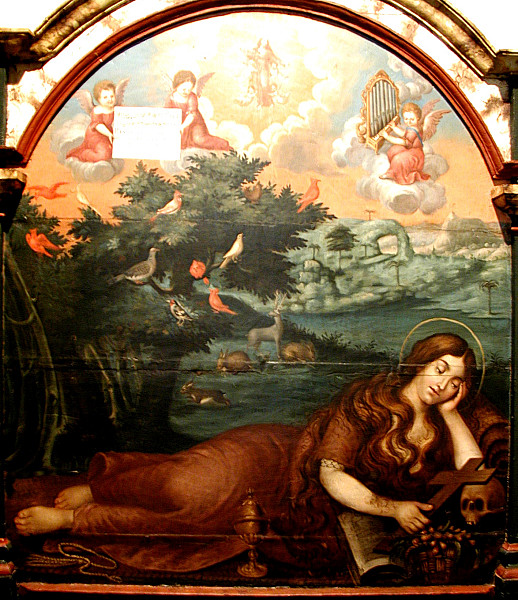Many medieval images place her anointing of Jesus' feet in the context of the Last Supper (example), although in the gospel narratives it occurs earlier in Bethany. She also appears as the "sinful woman" whose sins were forgiven at the dinner in the home of the Pharisee (example).
For Mary Magdalene's part in the story of her brother's resurrection, see the page for St. Lazarus. For the episode when Jesus visited her and Martha in their home, see the page for St. Martha.
MARY MAGDALENE AT THE CRUCIFIXION
A 6th-century manuscript illumination of the Crucifixion includes the three women followers named in Matthew 27:56, one of whom is Mary Magdalene. But she is not individualized, and in the Aquileia Crucifixion and Deposition frescos we see little more than the top of her head. Until the high middle ages she is included only infrequently in Crucifixions. However, in the 14th and 15th centuries there was a vogue for highly emotional images of Jesus' death, and the figure of a distraught Mary Magdalene became a favorite way of intensifying the sense of grief in the scene. In some images she raises her arms to Heaven in anguish (example); in others, she clings desperately to the foot of the cross (example).As the 16th century proceeds and artists find other ways to explore the emotional values of the Crucifixion, Mary Magdalene is less demonstrative in her grief (example) and also less likely to be included in the scene at all. (See the page on the Crucifixion.)
AT THE RESURRECTION
The 6th-century illumination mentioned above also has two scenes from the Resurrection narratives: the visit of Mary Magdalene and the other women to the tomb, and the Magdalene's encounter with Jesus in the garden, where he asks not to be touched. Both scenes came to be very common subjects in the art. For examples, see the page on the Resurrection.AS A CONTEMPLATIVE IN FRANCE
According to the Golden Legend, Mary Magdalene was expelled from the Holy Land by "miscreants" who put her into a rudderless boat with her brother and sister and Maximin, her spiritual adviser. Eventually they arrived in Marseille (image), where she began to preach the faith with eloquence and to great effect. Then she decided to retire to "a right sharp desert" for a life of prayer and contemplation. At each canonical hour Canonical hours are the times of the day appointed for prayer in the "breviary," the prayer book used by clergy and members of religious orders. the angels came and lifted her up in the air, where she could hear "the glorious song of the heavenly companies" (example). This was all the nourishment she required for thirty years. When it was time for her to die she sent word to Maximin, who called the clergy together in his church. The angels carried her there, and she received communion for the last time, a popular scene in medieval art (example).Images of the Magdalene in her cell were highly popular from the 16th century through the 18th. Like the third picture at right, they usually include the customary emblems of the contemplative life: a book, a crucifix, a scourge, a skull, and eyes fixed either on Heaven or on the crucifix. Like the earlier images of extravagant sorrow at the foot of the cross, they often seem to assume that the extreme passion that once led Mary Magdalene to be a "sinner" continued to characterize her in her reformation. Her clothing is often scanty (example) and her expression evidences a more intense experience of the divine (example) than, for example, pictures of St. Jerome in similar circumstances. In this she may be serving as a model for the viewer. In the Carmina Burana Passion Play this appears to be the purpose of her anguished repentance:
Alas, alas that ever I was born:A counsel similar to those last two lines is inscribed on a Croatian reliquary bust from the 14th century: ne desperetis vos qui pecare soletis exsemploque meo vos reparate deo., "O you who lived in sin, do not despair; follow my example and be redeemed by God."3
I have deserved the anger of God
who gave me soul and body —
alas, most wretched woman that I am!
Alas, alas that ever I was born,
now that God's anger awakens me!
Courage, good men and women all:
God wants to guide body and soul.2
A similar image type has her in her cell experiencing an ecstatic vision of the cross, which is carried to her by angels (example). A painting of the Pietà from the 15th century makes an anticipatory reference to this image type.
Modern scholars agree with the 12th-century writer who dismissed the account of Mary Magdalene's life in the desert as a mere borrowing from the life of St. Mary of Egypt, and indeed even Giotto got the two Marys confused in his fresco of Zosimus and the Magdalene, in which the Magdalene is clothed only in her long hair.4 The story of the saint's journey to France was concocted in the mid-11th century by the monks of Vézelay Abbey, who claimed that her body had been moved there from the Abbey of St. Maximin in Provence, where she had died. At the beginning of the 12th century, the cathedral in Autun attached to the story a claim that it had the remains of Mary's brother Lazarus and that he had accompanied her to France. Then St. Martha was added to the story. In Tarascon, Provence, her body was "found" in 1187 and a legend was composed in which she and her siblings had traveled into Provence along the Rhone River, where Martha vanquished the Tarasque, a legendary river monster. Before the 11th century it had been generally accepted that the Magdalene had died and been buried in Ephesus, and Lazarus in Cyprus, but the French inventions came to be accepted by writers and artists throughout the western church.5
PORTRAITS
The cross of these ecstatic visions is sometimes used as an attribute (example), but by far the saint's most common attribute is the alabaster jar from which she anointed Jesus. It is always of a size to be held in one's hand, usually with a top that tapers to a finial or cross and sometimes supported by a round "foot" (example). (Domenico Tintoretto's portrait of the Magdalene in her cell, however, gives her a pair of open-top blackware jars.)The saint herself is usually depicted as young and beautiful, with long, blond hair that flows loosely over her shoulders, as in the first and third pictures at right. (One exception: a gaunt, tired-looking Magdalene in this painting in Rome).
In an unusual painting that I found in an obscure corner of Santa Maria sopra Minerva in 2007, a female figure with flowing blond hair points to the words magistra apostolorum in a book held by St. Barnabas. The phrase means "(female) teacher of the Apostles." It normally refers to the Virgin Mary, but nevertheless the figure in the painting may be St. Mary Magdalene, who was frequently praised by writers of the 12th and later centuries as Apostola Apostolorum, "Apostle (female) of the Apostles" (Jansen, 57-97, Head, 662). See my page for the painting. In 2010, however, a reader wrote me that now the painting is nowhere to be found in the church.
Prepared in 2014 by Richard Stracke, Emeritus Professor of English, Augusta University.
HOME PAGE

A panel in Vivarini's Polyptych of the Virgin and Child, 1449 (See description page)

Vitale da Bologna, The Resurrection with Mary Magdalene ("Noli me Tangere"). (See the description page.)

This 18th-century painting puts the saint outside the entrance to her cell (on the left) but with all the objects typical of the contemplative life.(See description page)
ATTRIBUTE
- Ointment jar
MORE IMAGES
- 1309-20: Giotto's fresco series on the Magdalene in Assisi includes this panel for the anointing of Jesus' feet and this one for the voyage of Mary Magdalene and the others to Marseille. His fresco of the Magdalene lifted to heaven pictures her à la Mary of Egypt, clothed only by her own hair.
- 1320-25: Mary Magdalene appears among the attendant saints in Jacopo del Casentino's Madonna and Child Enthroned.
- 1325: In Lorenzetti's Madonna and Child with St. Mary Magdalene and St. Dorothy the Magdalene wears an image of the "Holy Face" on her breast.
- 1390s: A portrait of St. Mary Magdalene with her ointment jar and flowing blond hair is included in the right wing of Cenni di Francesco's Coronation of the Virgin Altarpiece.
- 1440s: Fra Angelico's Noli Me Tangere in a Franciscan friar's cell.
- Early 16th century: A Spanish portrait of Mary Magdalene with her two siblings.
- 1505: The saint's jar is made of clear glass in Bellini's Madonna and Child with Saints.
- 1514-1515: The predella of Bartolomeo Montagna's St. Mary Magdalene Altarpiece confuses the legend of St. Mary Magdalene with that of St. Mary of Egypt.
- 1515-17: In Correggio's Saints Peter, Martha, Mary Magdalene, and Leonard
- End of the 16th century: A sculpture of St. Mary Magdalene in contemplation.
- 17th century: Anonymous (after Veronese), The Dinner in the House of the Pharisee.
- 17th century: Novelli's Communion of St. Mary Magdalene
- 17th century? A painting in Seville of the saint's "passing" to Heaven in which a last communion is not shown.
- Circa 1660-65: Giordano's Ecstasy of St. Mary Magdalene shows the angels taking her up to hear the heavenly choir.
- 1700: Celesti, St. Mary Magdalene Washes the Feet of Jesus
- 1753: In the margin of a Mexican nun's badge.
- 19th century: A watercolor at the Smithsonian's Freer | Sackler Gallery is online under the title "Reclining Woman with Cross and Skull" but has all the characteristics of Mary Magdalene contemplative portraits. (Thanks to Ms. Amira Ashry for directing me to this image.)
- Undated: Mary Magdalene's statue is among the eight that flank Peter and the Virgin Mary in the St. Peter Altarpiece at the "Frari" in Venice.
DATES
- Feast day: July 22
BIOGRAPHY
- Golden Legend #96: html or pdf
- Also see the translated French texts in Head, 655-74.
- Mary Magdalene's conversion is the subject of lines 41-151 of the Carmina Burana Passion Play (Dronke, 202-213.
- "Miracula S. Mariae Magdalenae," in the Windbergen Legendary, ed. Carolus de Smedt et al., Analecta Bollandiana, XVII (1898), 177-79.
ALSO SEE
NOTES
1 See homily XXXIII in Gregory the Great's 6th-century Homiliae in Evangelia (Migne LXXVI, 1075-1312, Hurst 269-78). It is important to understand that Gregory's identification of the Magdalene as a repentant sinner is intended as praise. He contrasts her open-hearted acceptance of salvation with the Pharisee's arrogant presumptions, and he compares that arrogance to the airs put on by some contemporary clergymen. For Mary of Bethany see Luke 10:38-42, John 11:1-42, John 12:1-3. The unnamed woman with the jar of oil is in Luke 7:37-38, where Pharisees object that she is "a sinful woman" with whom Jesus should not associate, and in Matthew 26:6-7 and Mark 14:3-9, where bystanders object to the waste of costly oil.
2 Dronke, 211-213.
3 Petricioli, 17. Partly gilded silver bust, 1332. In the treasury at Zadar Cathedral.
4 Jansen, 65-66.
5 See Duchesne, "Légende," and Vacandard's rejoinder to Duchesne's critics.